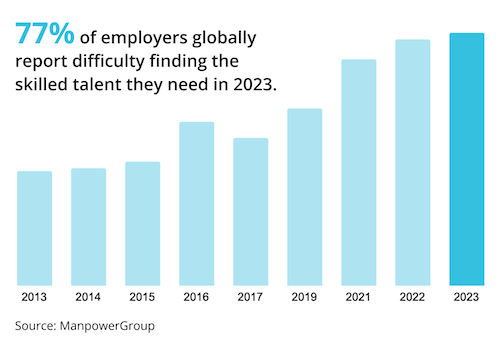A recent ManpowerGroup survey of 39,000 employers uncovered a stark picture of today’s talent market. In 2023, 77% of employers reported difficulty finding the skilled talent they need to remain competitive, the result of a 17-year high in global talent shortage.

What’s causing this talent crunch? Three distinct trends can help explain why companies are struggling to hire the leaders they need to take their business forward.
1) Record-low unemployment: More people are employed than ever before, leaving fewer available candidates in the talent pool. (source)
2) Baby boomer retirement: A large wave of experienced professionals are reaching retirement age, creating a significant knowledge and expertise gap.
3) Exponential company growth: With increasing business formation and expansion, demand for skilled talent is skyrocketing, further tightening the talent pool.
The result? Fewer potential hires coupled with a loss of experienced professionals have left a growing number of companies in an expensive, drawn-out competition for talent, exacerbating critical skill gaps across industries, functions, and seniorities.
Good news: while this feels bleak, there is a better solution.
Increasingly, high-performing organizations are taking a “build vs buy” approach to building their talent pipelines for critical leadership roles. By “building” agile, effective leaders from within the company, organizations save money in the short term and set themselves up for greater long-term success.
4 reasons to build your leadership pipeline from within
Leadership development is not a new idea, but the economics have now shifted making the cost and risk of “buying” talent from the outside unfavorable compared to the benefits of “building” leaders with desirable skills from within. Effective leadership development strategies can improve the alignment of these homegrown leaders with your business needs.
Investing in the development of high-potential employees can unlock a powerful leadership pipeline, reaping many benefits:
1) Retention of institutional knowledge: This is challenging to replace and time-intensive to acquire. A Panopto survey found that inefficient knowledge sharing contributes to annual productivity loss amounting to more than $13 million (for companies with 5K employees)*. Homegrown leaders retain and more efficiently share institutional knowledge that drives business impact. Moreover, they become custodians of an organization’s unique culture and history.
2) Increased employee loyalty & retention: Investing in employees’ growth fosters a sense of value and commitment throughout the organization. It fuels motivation, improves performance, and reduces costly turnover. ExecOnline analysis of data from Gallup, US Social Security, and US Department of Labor Statistics estimates that turnover can cost organizations with 10K employees up to $32 million annually.
3) Strengthened employer branding: Investing in your people’s potential shows employees and job seekers you care about their growth, attracting and retaining top talent. This builds a loyal and engaged workforce and a reputation as a company that invests in its future, making you even more competitive in the talent market.
4) Save money: High-potential employees are an investment in your future, but costly to replace. Recruiting and onboarding top talent can cost 4x more than developing your existing workforce. By investing in high-impact learning and coaching, you equip HiPos with the critical leadership skills they need, building a robust pipeline at a fraction of the cost. This strategic investment delivers a sustainable leadership foundation that saves money and outperforms expensive talent acquisition in the long run.
3-step quick-start guide to building your high-potential leadership pipeline
Before organizations can rapidly scale and increase the pace of leadership development—particularly of less-experienced employees—a necessary first step is the creation of a solid leadership development program built to nurture the employees with the highest potential to succeed in leadership roles.
1) Identify high-potential (HiPo) employees with the potential to succeed in higher level leadership roles at your organization. Your selection criteria may include factors such as job performance, adaptability, demonstrated ability to learn new skills and adopt new technologies, and emotional intelligence. 360-degree feedback collected from peers, direct reports, and cross-functional collaborators can give you a nuanced picture of employees’ abilities, attitudes, and areas for professional growth.
2) Design a comprehensive leadership development program that builds the skills and capabilities aligned to your organization’s short-, medium-, and long-term goals. Choose or design a leadership development program that is flexible enough to adapt to the individual learning needs of each HiPo employee.
3) Offer ongoing coaching, feedback, and learning opportunities to ensure leaders continuously develop the relevant capabilities to lead during critical inflection points.
Building a high-potential leadership pipeline is not a “one-and-done” solution to the talent crunch, it is an ongoing process of strategically investing in your company’s most valuable asset: its people. By implementing these steps and fostering a culture of learning and development, you’ll cultivate a powerful talent engine that drives your organization forward.
*Source, Panopto: https://www.panopto.com/resource/valuing-workplace-knowledge/
*Source, ExecOnline: https://www.execonline.com/wp-content/uploads/2022/06/High-Cost-of-Burnout-Report-ExecOnline.pdf
